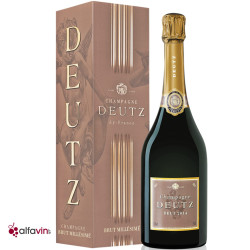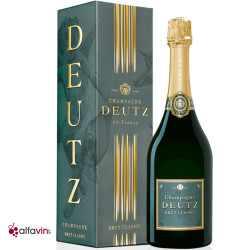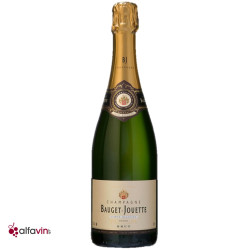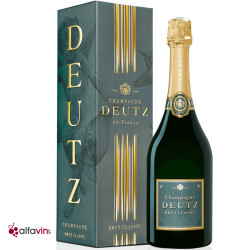- Home >
- Blog >
- advice-champagne-sparkling-wines >
- All our advice to choose your champagne for parties!
Champagne is the wine par excellence when there is an event to celebrate. Wine list, social evenings, family meals, sporting events, and many other occasions, champagne is present everywhere. It is the flagship product when there is someone or something to celebrate. Considered more as a brand than a wine, champagne enjoys an image and a notoriety that does not weaken. With an appellation spread over more than 33,000 hectares, more than 4,400 winegrowers and shippers, 39 cooperatives and 306 champagne houses, it is sometimes very difficult to find one's way around and choose a bottle of champagne.
How to recognize a good champagne?
Before talking about the quality of a champagne itself, let's take a look at the labels. In the jungle of labels, it is sometimes very difficult for the consumer to find his way. First of all, a label must bear the words
AOC Champagne and Product of France because a champagne can only come from this wine region of the same name and therefore from France. Another mandatory mention that must appear on a label and that proves the legitimacy of the product is the type of producers, and there are several:
CM for Cooperative of Handling, it buys the grapes from its members, takes care of the vinification and then markets the wines.
RC for Récoltant Coopérateur, a cooperative takes the grapes from a winegrower, carries out the vinification and then after the second fermentation gives the wines back to the winegrower who markets them.
RM for Récoltant Manipulant, he grows, vinifies and sells his own production.
NM for Négociant Manipulant, he buys grapes from winegrowers to produce and market his own champagne.
MA for Marque d'Acheteur, he buys champagne already bottled and puts his own label on it.
On the tasting side, to recognize a good champagne, you have to take into account certain aspects. Visually, the quality of the bubbles is very important. It must be fine with a continuous effervescence. When it is bigger, the bubble is more aggressive. A champagne is a clever mix of fine and unctuous bubbles with a balanced acidity and alcohol content. Depending on the type of champagne, some will be drier, others rounder, more expressive or more delicate.
The different types of champagne
There are different types of wines that can be produced in the AOC Champagne. The first one that can be mentioned and which represents the major part of what can be bought on the market and which is in the eyes of the
Champagne producers the brand image of the house, is the Brut without year or non vintage. This is the champagne that is produced every year and is the result of a blend of wines from the current year with so-called reserve wines to obtain the same taste, which defines the style of the house. It must be aged for at least 15 months to be classified as Brut sans année. The second possibility for the Champagne winemakers is the production of vintage champagne. This one is produced according to the quality of the vintage judged very good or excellent by each producer. In no case, a vintage champagne can be blended with other wines of different years. To be entitled to the mention of vintage, the wines must be aged on laths for a minimum of 36 months but we often see longer maturings being made by the producers. Then there are the "blanc de blancs" champagnes, that is to say wines made only from the chardonnay grape. These champagnes are finer and more delicate and have a great elegance. On the other hand, there are the so-called
"blanc de noir" champagnes, white champagnes made with the black grapes Pinot Noir and Pinot Meunier. These wines are rounder and more vinous. Finally, another cuvée exists, the rosé champagne. Rarer on the market, it is nevertheless an exceptional product. This type of champagne can be elaborated by blending white wines with red wines. Note that the Champagne appellation is the only French AOC that can use this method. Champagne producers can also elaborate rosé champagnes by crushing the berries (grapes with crushed red skins) and when the desired color is reached, the wines are racked and the manufacturing process continues.
Within this classification, we find the category of dosage. You have probably heard the terms brut, dry, semi-dry. This is the amount of sugar that is added to the wines during the final bottling, which defines the taste of the champagne and its classification.
Which champagne to buy for a festive meal?
Choosing which bottle to buy to celebrate an event is always a dilemma for many consumers. Beyond the budget devoted to this purchase which will condition the possible choices, there is in our opinion a question to which an answer should be given. "What type of champagne do you like? The choice is first of all a matter of taste. Each house having its own style, it is necessary to define the type of champagne you like. Floral and fruity cuvées, those with more buttery and toasted notes. Dry or more vinous champagnes. You like champagnes with a lively bubble or on the contrary with a more delicate bubble. Your taste will determine whether you should buy a
brut champagne or a demi-sec, a non-vintage cuvée or the opposite. When to serve champagne ? Champagne can be enjoyed at any time; the bubbles and the level of acidity in the wines mean that champagne can be drunk on its own as an aperitif, accompanied by toast. As well as if you wish to make a meal with champagne, the agreements are possible and wide. Shellfish, fish in sauce, white meat, cheese, desserts, everything is possible.
Brut champagnes prefer seafood and shellfish, the more vinous, round, vintage or non-vintage champagnes go wonderfully with meat or fish in sauce. Vintage champagnes with evolved notes go very well with certain cheeses. A rosé wine can accompany a fruit dessert for example. We often think that champagne should be drunk as an aperitif, but the possibilities of food and wine pairing are numerous and work very well.
Our advice to enjoy it at the right temperature.
The temperature is of primary importance for the tasting of a wine in general. Served too cool, the aromas do not reveal themselves on the nose and in the mouth, the wines are closed and not very or not expressive. On the other hand, if they are served too warm, the wines will be marked by alcohol. When you want to taste a bottle of champagne, you have to take into account the style of the wine because the temperature will not be the same. If you are in the presence of a Brut cuvée, the ideal serving temperature is between 6 and 8°; this type of champagne being less complex, with generally rather lively bubbles, supports a cooler temperature very well. Cuvées with finer and more delicate bubbles, richer and more complex aromas, prefer a temperature between 9 and 11°.
Discover all our articles on champagne: list articles + links of articles.
Discover our articles on champagne:The best Italian ProseccoWhat is the difference between a sparkling wine, a cremant and a champagne?How is sparkling wine is made5 ideas for aperitif cocktails with champagneFood and champagne pairing: what to eat with champagne?Our wines linked to this post

66.00 CHF

49.00 CHF

36.00 CHF

105.00 CHF










